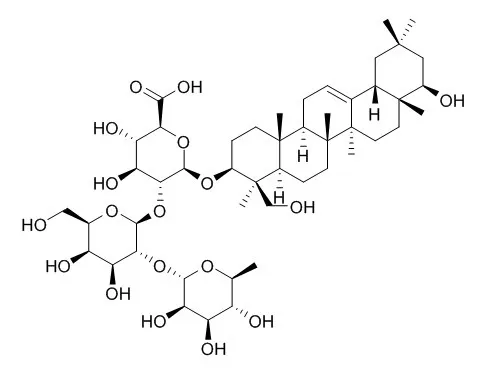| In vitro: |
| Wei Sheng Yan Jiu. 2010 Jul;39(4):444-6. | | Apoptosis effects on human esophageal cancer cells by soyasaponin Bb and its machanism.[Pubmed: 20726234] | To explore the effect and potential mechanism of apoptosis in the Eca-9706 cells induced by Soyasaponin Bb.
METHODS AND RESULTS:
Different concentrations of Soyasaponin Bb were on the Eca-9706 cell. Cell growth suppression rate was detected by MTT. Apoptotic rate was detected by TUNEL. The expression changes of HDAC1, NF-kappaB, PTEN, cyclin D1, c-met, VEGF or caspase-3 in the SSBb were detected by immunohistochemistry and immunoblotting.
Compared with the control group, the growth-inhibition rate and apoptotic rate were increased, the expressions of PTEN, caspase 3 were increased, the expressions of c-met, VEGF, HDAC1, NF-kappaB and cyclin D1 were decreased.
CONCLUSIONS:
SSBb can suppress Eca-9706 cell growth. SSBb can exhibit reverse effects on over expression of c-met, VEGF in Eca-9706 cells. Eca-9706 cell apoptosis can be induced by SSBb through inhibiting HDAC1-NF-kappaB and activating PETEN and caspase-3 signaling pathways. | | J Enzyme Inhib Med Chem . 2019 Dec;34(1):350-360. | | Soyasaponins from Zolfino bean as aldose reductase differential inhibitors[Pubmed: 30734590] | | Abstract
Seven triterpenoid saponins were identified in methanolic extracts of seeds of the Zolfino bean landrace (Phaseolus vulgaris L.) by HPLC fractionation, revealing their ability to inhibit highly purified human recombinant aldose reductase (hAKR1B1). Six of these compounds were associated by MS analysis with the following saponins already reported in different Phaseolus vulgaris varieties: soyasaponin Ba (V), Soyasaponin Bb, soyasaponin Bd (sandosaponin A), soyasaponin αg, 3-O-[R-l-rhamnopyranosyl(1 → 2)-α-d-glucopyranosyl(1 → 2)-α-d-glucuronopyranosyl]olean-12-en-22-oxo-3α,-24-diol, and soyasaponin βg. The inhibitory activity of the collected fractions containing the above compounds was tested for hAKR1B1-dependent reduction of both l-idose and 4-hydroxynonenal, revealing that some are able to differentially inhibit the enzyme. The present work also highlights the difficulties in the search for aldose reductase differential inhibitors (ARDIs) in mixtures due to the masking effect on ARDIs exerted by the presence of conventional aldose reductase inhibitors. The possibility of differential inhibition generated by a different inhibitory model of action of molecules on different substrates undergoing transformation is also discussed.
Keywords: Saponins; Zolfino bean; aldose reductase; differential inhibitors. |
|






 Cell. 2018 Jan 11;172(1-2):249-261.e12. doi: 10.1016/j.cell.2017.12.019.IF=36.216(2019)
Cell. 2018 Jan 11;172(1-2):249-261.e12. doi: 10.1016/j.cell.2017.12.019.IF=36.216(2019) Cell Metab. 2020 Mar 3;31(3):534-548.e5. doi: 10.1016/j.cmet.2020.01.002.IF=22.415(2019)
Cell Metab. 2020 Mar 3;31(3):534-548.e5. doi: 10.1016/j.cmet.2020.01.002.IF=22.415(2019) Mol Cell. 2017 Nov 16;68(4):673-685.e6. doi: 10.1016/j.molcel.2017.10.022.IF=14.548(2019)
Mol Cell. 2017 Nov 16;68(4):673-685.e6. doi: 10.1016/j.molcel.2017.10.022.IF=14.548(2019)